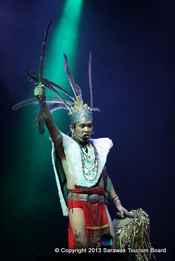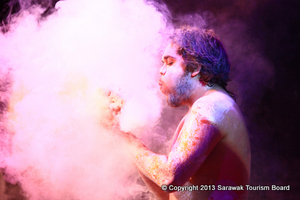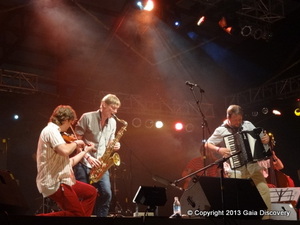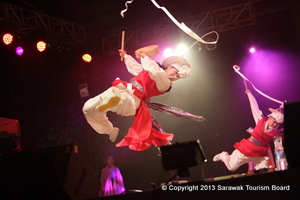Mallika Naguran checks in to Sarawak to check out the region's popular world music festival.
Kuching, 1 July 2013. The 16th edition of the Rainforest World Music Festival (RWMF) in Santubong, Sarawak was a highlight in Asia's world music calendar. As before, the organisers Sarawak Tourism Board and artistic director Yeoh Jun Lin brought in mega international acts to perform alongside lesser known ones – striking varied rhythms to unleash vibrations of energy – from meditational low to fever pitch high. Festival-goers of nearly 20,000 over three days lapped it all up, 80 percent of which were mostly from West Malaysia and beyond, according to Angeline Bateman, communications director of Sarawak Tourism Board.

Sarawak native chanting for blessing

Dizu Plaatjies & The Ibuyambo Ensemble

Australian native gig Nunukul Yug
This year, RWMF 2013 showcased great acts from the corners of the world. Literally! Australian aboriginals Nunukul Yug; Ukrainian Spiritual Seasons; Habadekuk from Denmark; Kila from Ireland; Dizu Plaatjies & The Ibuyambo Ensemble; Kries from Croatia; Alp Bora from Turkey; Pine Leaf Boys from Lousiana; Chet Nuneta from France; Mohsen Sharifian & The Lian Band from Iran; Rey Vallenato Beto Jamaica from Colombia; and Palsandae from Korea.

Nunukul Yug
On the home front were heritage showcases of culture set to music. The audience loved the local Borneo and Southeast Asian acts for their authenticity. From Sarawak, we had Maya Green, Gema SLDN-SCV, Lan E Tuyang (led by Matthew Ngau Jau) and Madeeh (featuring Arthur Borman “Bai Kas” Kanying). Malaysian Rhythm in Bronze gave uplifting gamelan and gong sounds, a pleasure to watch and listen to. Rafly Wa Saja crunched the spiritual nuances of Acehnese folk with groovy vocals using scat technique improvisation.
Australian aboriginals Nunukul Yuggera commanded attention with their narrative styled acts relating stories close to the heart of the people. There were adulations of dolphins for their role in saving mankind. There were calls made to the spirits for the protection of earth. There was a live demonstration of the art of making fire from sticks and hay. Yes, the way things used to be back in the good old days before the invasion of electric stoves and microwave ovens!
High-energy performances by Kila and Habadekuk stole the limelight, got audiences raving and dancing on their feet, while Colombians sent Latino-styled currents to the crowd but with authentic Cumbia and Vallenato performances. Alberto “Beto” Jamaica had a few years ago gotten a name for being the best accordionist in Bogota for Vallenato style music, pitting against 100 others to clinch the first position. Indeed, the Latino Vallenato folk compositions were among the highlights of the evening.

Habadekuk
While smoothly run most of the time, the festival programming seemed halting with Sarawakian performances coming on in between with bigger sounding acts. The music revelers that had their hands high and feet thumping before suddenly stood still to soak in meditational sequences and chants. From the programming perspective, this might have been deliberate, to try to inject some variety, alternating the pace for some relief. For some, it was time to visit the loo and grab the beer, passing over the rather pricey wine at RM18 for a puny glass.

Korean Palsandae
Kries from Croatia was beautifully dark, haunting and gothic, but not quite the right band to slot in as the night’s anchor. Prior to it was Dizu Plaatjies & The Ibuyambo Ensemble - the pride of South Africans. Once again, as in most world music gigs, the Africans delivered! There were every minute mesmerizing, culturally engaging, danceable and melodioius with amazing vocal harmonies. The call to remember ailing Nelson Mandela, South Africa's first black President and all that he brought to South Africa was touching. After all what is world music if there aren’t any activist rejoinders?
But there’s only so much that one can write about music. To appreciate these musicians, you’ll have to buy their CDs and listen to their tracks. Hook up with their vids online, or watch this space for Gaia Discovery video posts. Better still, be there in Sarawak next year to enjoy some wonderful world music, actually among the best in this region, and that can only happen at the Rainforest!
Photography by Mallika Naguran and Sarawak Tourism Board.
Read Gaia Discovery's article on Chet Nuneta's reasons for singing in disappearing languages.